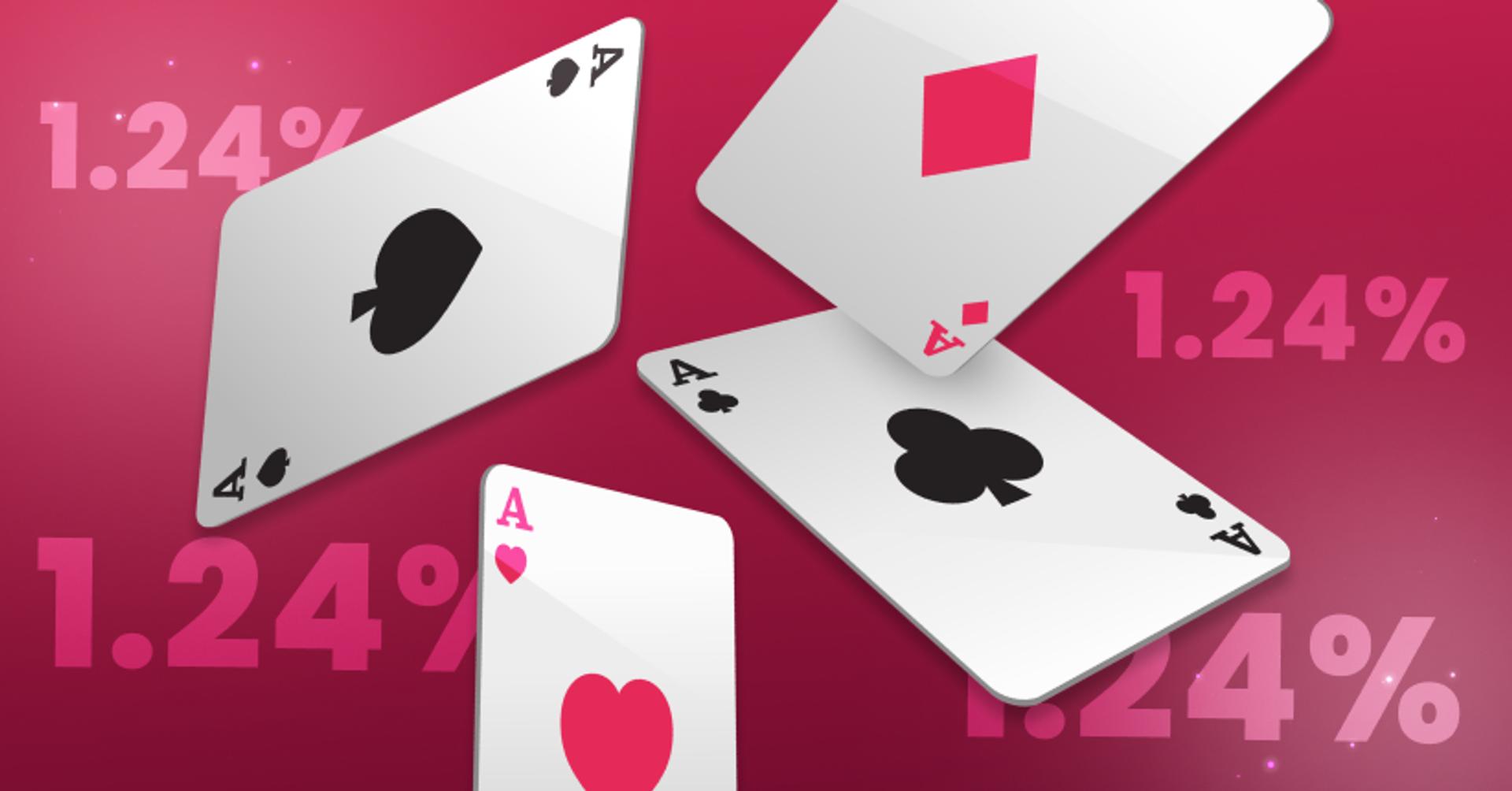Baccarat Odds: Banker vs Player vs Tie House Edge 2025

Baccarat might be one of the easiest casino games to follow, but understanding baccarat odds is what turns it from pure luck into better strategic play.
Many new players believe Banker and Player are equal choices, but the numbers reveal they aren’t the same. Each bet, Banker, Player, or Tie, comes with its own payout and long-term house edge.
By learning these differences, you may avoid risky bets. You can also focus on the safer options available on Jackpot.bet, and play with more confidence every round.
Understanding the Baccarat's House Edge on Jackpot.bet
The term house edge might sound complicated, but it’s really just the casino’s built-in advantage over time. Instead of focusing on a single hand, think about what happens when you keep playing the same bet hundreds or thousands of times.
For example, if you wager $100 on a bet with a 1% house edge, the casino expects to keep about $1 on average, while you’ll get back $99. You might win or lose more in the short run, but over many rounds, the math balances.
Due to this, the specific rules and payouts in Baccarat matter so much. Small differences, such as a 5% commission on Banker or an 8:1 payout on Tie, might impact the house edge and shape your long-term results.
Banker Bet Odds and House Edge
Among all Baccarat bets, the Banker is usually considered the strongest option. It offers the lowest house edge, giving you possibly better winning odds over time.
Payouts and Commission
When you bet on Banker and win, the payout is 1:1 minus a 5% commission. It means if you place $20 on Banker, a straight 1:1 payout would give you $20 in profit.
However, the 5% commission subtracts $1, so your actual win is $19. The commission might feel small, but it’s what keeps the bet balanced.
House Edge Calculation
Thanks to the way cards are dealt, the Banker has a slightly higher chance of winning. Even after the commission, the house edge is about 1.06%, the lowest in Baccarat.
Put into real terms, if you wager $1,000 on Banker over time, your expected average loss is around $10.60. It is significantly less than what you’d risk on Player or Tie.
The Advantages of Betting on the Banker
Statistically, Banker wins about 45.8% of all hands, compared to Player’s 44.6% and Tie’s 9.6%. The commission is the casino’s way of leveling the field. Without it, the Banker would be too favorable for players.
Simply put, Banker gives you the best long-term value, which is why experienced players often stick to it.
Player Bet Odds and House Edge
The Player bet is the natural alternative to the Banker. Many beginners choose it because the payouts look simpler.
Payouts
When you bet on the Player and win, the return is 1:1 with no commission. If you put down $20 and win, you get $20 profit plus your original stake back.
It’s more straightforward than Banker since there’s no deduction to calculate.
House Edge Calculation
The simplicity of the Player bet comes with a small price. The house edge on Player is 1.24%, slightly higher than Banker. In terms of baccarat winning odds, the Player has around a 44.6% chance of winning in any given hand.
Over the long run, this means that for every $1,000 you wager, your average expected loss is about $12.40. The difference from Banker might not sound huge, but it adds up over time.
When Player Bet Might Be Preferable
Banker has the better math, but some players prefer the Player bet because they don’t want to deal with commission cuts. It also fits better with flat betting systems, where you keep bets constant round after round.
If you prefer casual play or simplicity, the Player bet can feel like the more comfortable option. Its house edge is a bit higher than the Banker’s, but the difference is insignificant.
Tie Bet Odds and House Edge
The Tie bet is the flashiest option in Baccarat because of its big payout, but it’s also the riskiest. If you understand this bet, it can help you decide if this wager fits your strategy and bankroll.
Payout Options
Most baccarat tables pay 8:1 on a Tie, which means a $10 bet returns $80 profit plus your stake. Some casinos, however, offer a better deal at 9:1, giving $90 profit on the same $10 bet.
At first, these payouts look good, especially compared to the even-money wins from Banker or Player.
House Edge Calculation
When the payout is 8:1, the house edge is around 14.4%, one of the worst bets in the casino. If you find a table paying 9:1, the house edge is 4.85%. That’s better, but still much higher than the Banker or Player bets.
The Risk of Betting on a Tie
Ties occur in only about 9.5% of rounds, meaning you’ll likely wait a long time for a win. It’s like betting on a long-shot horse at the racetrack.
You might score a big payout if it comes through, but most of the time you’ll walk away empty-handed. For beginners learning the ropes of Baccarat, Tie can be exciting, but rarely a smart long-term choice.
Comparing Banker vs Player vs Tie Odds in 2025
Baccarat is often seen as a simple game, but the numbers show a big difference between the three options.
Now that we’ve broken down each bet on its own, it helps to see how they stack up side by side:
|
Bet Type |
Win Probability |
Payout |
House Edge |
|
Banker |
~45.8% |
1:1 (minus 5% commission) |
~1.06% |
|
Player |
~44.6% |
1:1 |
~1.24% |
|
Tie |
~9.6% |
8:1 (sometimes 9:1) |
~14.4% at 8:1 / ~4.85% at 9:1 |
So, the Banker bet has the lowest house edge and wins just a little bit more often than the Player. The Player bet is a close second, offering no commission but a marginally higher edge.
Meanwhile, the Tie bet lags far behind at most tables, carrying a massive house edge unless you find a rare 9:1 payout.
Real-World Examples of Expected Results
It’s one thing to see percentages on a page, but the math really makes sense when you look at how it plays out in practice.
Let’s say you sit down at the table and place a $10 bet every round for 100 hands. That’s $1,000 wagered in total, and here’s what you’d expect on average:
-
Banker: With a 1.06% house edge, the average loss is around $10.60.
-
Player: At 1.24%, the expected loss increases slightly to about $12.40.
-
Tie (8:1): With a 14.4% house edge, the loss rockets up to $144, showing just how expensive this bet can be over time.
Variations That Change the Odds
Not every baccarat table follows the same structure, and a few small changes can shift the odds against us. One version you often see is No Commission Baccarat.
The Banker pays even money, but winning with a six comes with a reduced payout. Such a tweak barely raises the house edge compared to standard rules.
The Tie payout is another factor. Most tables pay 8:1, but when you find a 9:1 option, the house edge drops from 14.4% to 4.85%. It’s still risky, but the improved payout does make it more attractive than the standard Tie.
Unlike land-based casinos, our Baccarat Originals game on Jackpot.bet displays all the rules clearly. Players always know the exact payouts and house edge before placing a bet.
However, in traditional casinos, the fine print can be easy to miss.
Tips for Beginners on Jackpot.bet
When you first start playing Baccarat, the best thing you can do is slow down and pay attention to the table rules. Small details, such as whether the Banker commission applies or what payout is offered on a Tie, make a significant difference to the odds you face.
Once you know the rules, your safest approach might be to stick with Banker or Player bets. They offer the lowest house edge, keeping your bankroll lasting longer. The Tie bet might look exciting, but unless the payout is 9:1 or better, it usually costs you far more than it returns.
Another key tip is to set a budget before you play and stick to it.
Pro Tip: If you’re interested in other games where strategy can reduce the casino’s advantage, it’s worth checking out our guide on Master Blackjack Odds: House Edge Secrets Revealed 2025.
Conclusion
Baccarat may seem simple, but the baccarat odds reveal clear differences between bets. Banker is the best long-term option with a house edge of about 1.06%, followed by the Player bet at 1.24%.
By comparison, Tie is the riskiest, carrying a steep 14.4% edge at 8:1 unless a rare 9:1 payout is offered. Focusing on math instead of pure luck helps you make better choices and enjoy steadier play.
On Jackpot.bet, you can always see the odds clearly on our provably fair tables, so every hand is played with confidence.
Frequently Asked Questions
Is Baccarat actually 50/50?
Baccarat isn’t a true 50/50 game. Banker wins about 45.8% of hands, and Player wins about 44.6%. The small difference, along with commissions and payouts, creates the house edge.
What is the success rate of Baccarat?
On average, Banker wins slightly more often than Player, giving it the highest success rate in the game. Tie wins are rare, occurring in less than 10% of rounds.
What are the odds for even money in Baccarat?
Even money payouts apply to both Player bets and Banker bets, with the Banker’s commission already applied. The Player’s house edge is around 1.24%, while the Banker’s edge is about 1.06%.
What are the odds to win in baccarat?
They are roughly 45.8% on Banker, 44.6% on Player, and 9.6% on Tie. The figures explain why Banker is usually the preferred long-term option for players.









